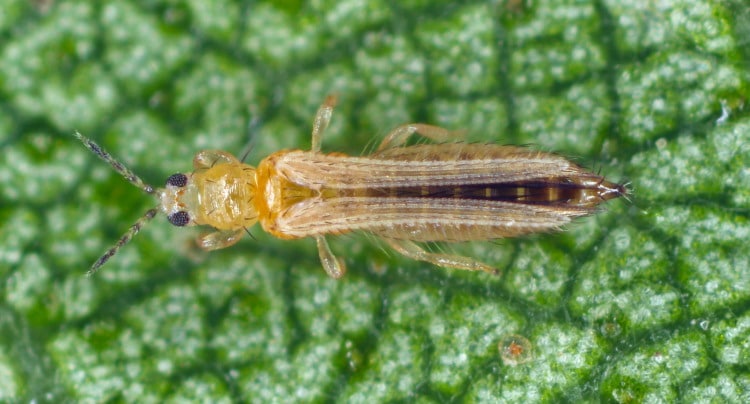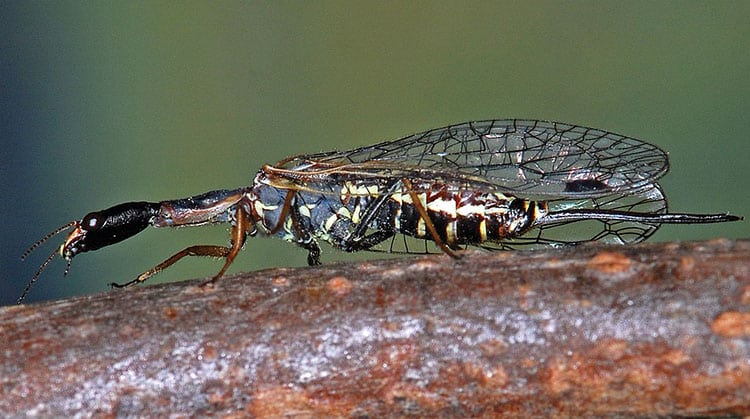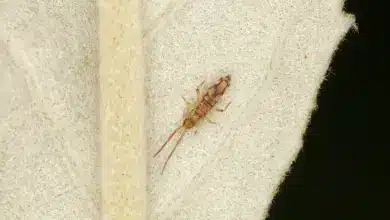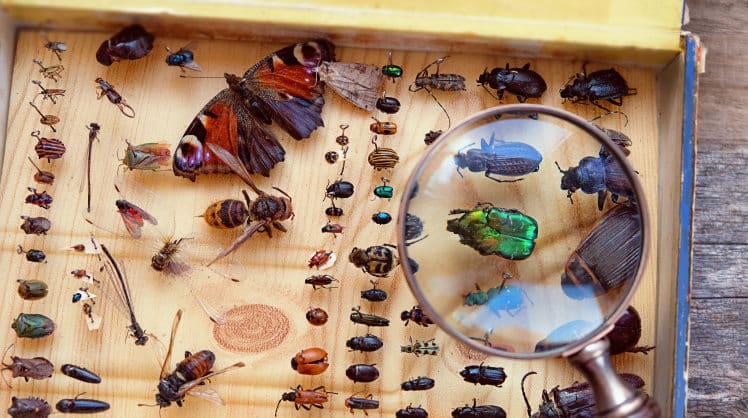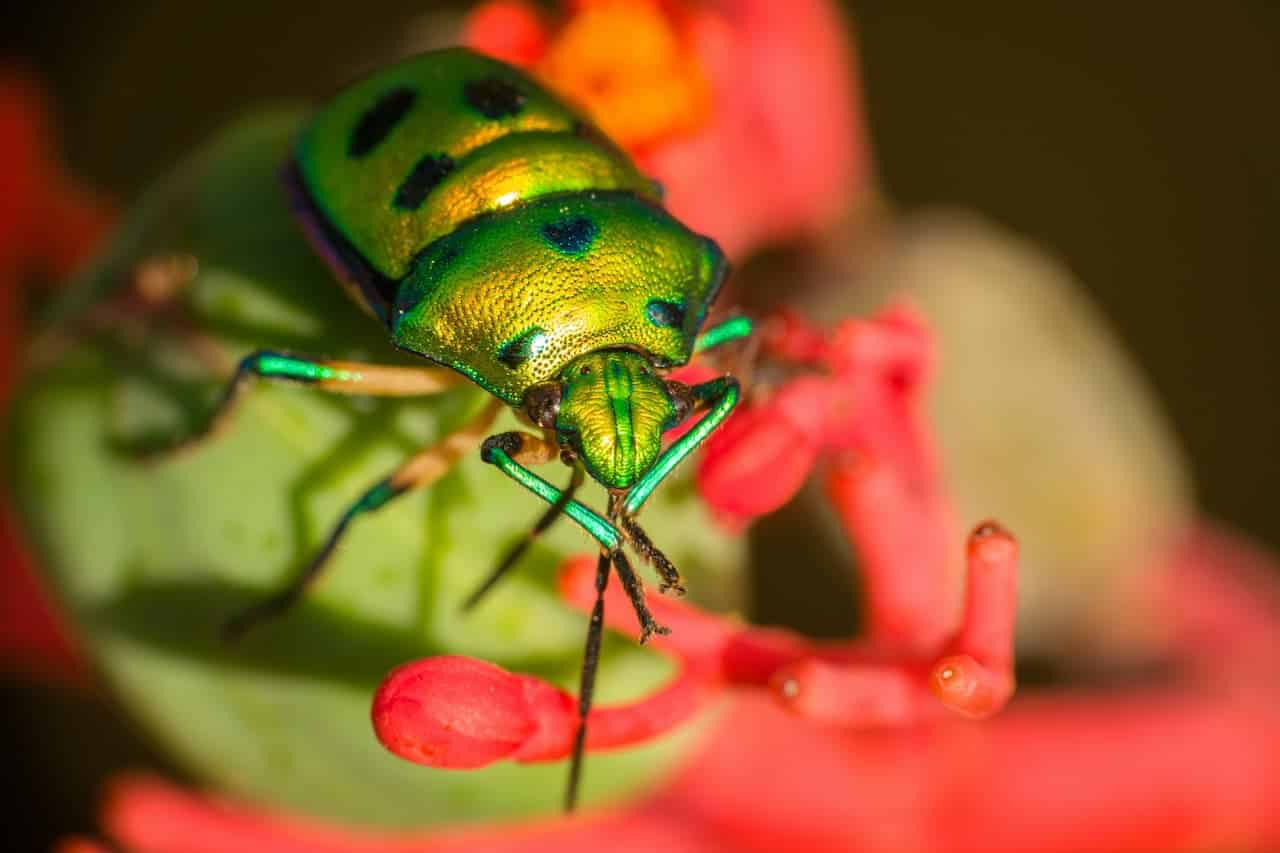10 Best Insect Books: For Adults & Kids Alike
Welcome to our page covering all the best insect books we’ve reviewed over the last 20 years or so.
If you’re specifically searching for insect books for kids, then please skip to the end instead.
1. Biological Atlas of Aquatic Insects
This rather unusual book from Apollo Press came as a pleasant surprise. However, I had a little difficulty deciding how to classify it.
It is a fascinating book to browse through, yet it deals only with a few examples of each family – so it could not be called a text.
In the end, I decided to describe it as a coffee-table resource, meaning that it has many of the properties of a coffee table book but is also a useful information resource.

The book is wide-ranging in that it includes insects from all continents and a wide variety of habitats.
The book is dedicated to those insects that live at least part of their lives in water; it comprises 900+ SEM photos of excellent quality and with magnifications ranging from 2.5 to 12,000.
The central themes of the book are the ‘basic functions of an aquatic life’, respiration, and osmoregulation have been described for all groups of insects, including Collembola, which possess aquatic members.
Many of the plates show sections of the animal’s anatomy at several magnifications.
Each plate has six photos, and opposite it, there is a textual reference to the relevant aspects of the animal’s biology as illustrated in the plate. There is also a title description of each photo on the plates.
The textual information itself is vast, ranging over the entire field of aquatic entomology, and would amount to a 170-page text of the morphology and physiology of aquatic insects.
The beauty of many of the microstructures of the insect cuticle, and sometimes also its ugliness, are well illustrated in this fascinating volume.
I can see this insect book being of great interest and enjoyment to both professional and amateur entomologists, as well as being of great value to researchers and students who have in any way to deal with the ecology, morphology, and/or physiology of aquatic insects.
As usual with books from Apollo Press, this volume is not only attractively produced but also attractively priced.
Highly Recommended

2. Maggots, Murder, and Men
Zakaria. Erzinçlioglu’s or Dr. Zak’s (as he is known by the police) fascination with blowflies and their kin was already known to me through his excellent volume for the Naturalist’s Handbook Series on Blowflies.
I was quite pleased then when Harley Books offered me a copy of this volume to review for my website.
Forensic entomology is a fascinating, if somewhat gruesome, discipline that I am glad somebody else does.
I started this unsure how well it would hold my attention; having already read M. Lee Goff’s “A Fly for the Prosecution,” I wondered what Dr. Zak could say that was new.
I needn’t have worried; while the basic science is the same in the two books, their presentation and scope are quite different.
It may come as a pleasure to those who are interested in crime but not so much in insects that this book does not delve so deeply into the life cycles and ecological successions described by Mr. Goff.

This book has a far more wide-ranging scope and unleashes far more interesting aspects of forensic science than just flies, though obviously, as part of the central theme of the book, they are present throughout.
Zakaria. Erzinçlioglu displays not only his fascination with the lowly flies that are attracted to human corpses but also his in-depth knowledge of the human-fly sphere of interaction throughout history.
There is a chapter charting the history of maggots and medicine, an interesting look at how flies have affected human history, a chapter on missing persons, and some very pertinent comments on the ailing of society in the UK today.
As someone who has spent some time in the public eye as an entomologist, I was also able to sympathize with him in his dealing with Delusory parasitosis, people who want you to identify bugs with practically no information, and insulting mail from people who do not agree with things you have written.
All this made it a very pleasant read for me, even though my stomach turned to reading the gruesome details of rape, murder, and pedophilia.
However, the book is well written and grows on you as you get further into it, the varied diet makes it an easier read than Goff’s book, and its different approach makes it a complementary read rather than a competitor.
I suspect anybody with an interest in crime, or perhaps even humanity, will find this interesting.
Highly recommended

3. Amazon Insects: A Photo Guide
This is a small, well-presented insect book that is hard to categorize for the audience.
Despite what the author says in the introduction, I think it will primarily be of use to tourists with only a casual interest in invertebrates and not biologists.
If the format of the book had been four times larger, I would have said it would make a nice coffee table expose to rainforest insects.
If it had contained ten times as many insects, or maybe 50 times as many, I could have said it was a useful guide to S. American Rainforest invertebrates. As it is, the book falls somewhat unhappily between these two.
The insects chosen are beautiful, even spectacular, as are the few other invertebrates that are included.
Also, there is no doubt about the quality of the photos – they are all excellent. Further to this, the text, though brief, is accurate and informative.
This book’s size and colorfulness not only make it something acceptable to ordinary tourists to carry in their bags along with a bird and plant guide but will also allow it to fill another niche, as a present to a school child or young kid.
The high quality of the images and the small format could well make it an accessible and inspiring window into the fascinating world of rainforest invertebrates.

4. In a Desert Garden: Love and Death among the Insects
Reading this book for me was a case of love at first sight/read. Alcock is an entomologist with a great love of his subject, and this love shines through this book, enlightening and uplifting it.
The great work in the entomological world at the moment is not Pest Control, Genetic Research, or even Taxonomy and Classification.
It is overcoming that irrational abhorrence of insects that pervades the minds of most people of the world. Or at least people in the Western portion of the world anyway.
John Alcock’s book about insects, with its easily read-flowing style and its oozing enthusiasm, is a major lintel in the house of human-insect reparation.
It is the story of his abandonment of the ubiquitous grass lawn that so many Americans strive to maintain in the face of Nature’s opposition.
It describes the methods and means of how he went about converting his garden into a little patch of near-native desert. It then goes on to share with us the joys of having the native wildlife return to your garden.

The maintenance cost of these thousands of lawns in Arizona and nearby states is phenomenal, not just in terms of money but in terms of damage to the environment.
The more people who follow John’s lead, the better place Arizona will be to live in, and the more balanced and at peace the environment will be.
John Alcock shows in this book that even in a suburban habitat like Tempe, Arizona, living in harmony with nature is easier, cheaper, and more enjoyable than attempting to subdue it.
Though I love what John Alcock has done in his garden and hope fervently that millions of Americans will follow his lead, I love even more the fact that he has written this book to encourage others to escape the barrenness of an unnatural grass sward for the beauty of the fertile desert.
Buy this book, give to friends and enemies alike, put it in your local library, and of course, read it and learn from it yourself.
Highly Recommended
5. The Thermal Warriors
Phrases like absolutely amazing and simply incredible spring to mind quite readily after reading this delightful insect-themed book.
I must admit that as both an Amateur naturalist and a professional entomologist, I was surprised to discover how little I was aware of the importance of thermoregulation in the lives of some of the higher insects.
This book has added a whole new wonderful dimension to my insect watching.
The illusion that all insects are cold-blooded is shattered. From moths that raise their thoracic temperature to 40C before they can fly to honey Bees which live in an environment that is air conditioned to a higher degree of control than most of our homes and offices, this book is fascinating.

Bernd Heinrich is the guru of insect thermoregulation, but he is also a competent writer, and his enthusiasm for his subject is infectious.
This book should be a must on everybody’s reading list regardless of profession. You need to know previous entomological experience to read this book but be warned; you will probably be hungry for more by the time you have finished it.
Apart from staying hot, this book also deals with the problems of staying cool, but perhaps most exciting of all is the revelation of the new eco-friendly methods of pest control that stem from our new understanding of insect thermal limitations and the equally frightening revelation of the efforts the biochemical companies are making to discredit and hush up this new knowledge.
All in all, one of the most fascinating insect books I have read this year. Highly Recommended.
6. Insects Through the Seasons
“Insects Through the Seasons” is a book for insect lovers of all ages. Gilbert Waldbauer is an accomplished scientist with extensive knowledge of entomology.
Yet, he writes with a fluid and easily readable style that is most pleasant. He possesses the ability to explain things in a simple and straightforward manner that will appeal to readers at all levels of entomological expertise.
Though many professional entomologists will be familiar with the contents, as this book is obviously aimed at the novice entomologist of any age.

Ostensibly the book follows the development of Cecropia moths throughout the year, but as the book progresses, the Cecropia moths come to be lost from time to time as Gilbert warms to his subject of entomology as a whole.
Really this is a book about the wonder of insects and the amazing things they do in order to survive day-to-day life in various parts of the world.
A picturesque journey into the world of those six-legged marvels that we all love. In his wanderings, Gilbert brings in just about the whole of entomology and draws on a wide range of species to illustrate the various themes.
Includes chapters on: First Things, The Most Successful Animals on Earth, Finding and Courting a Mate, After the Courtship’s Over, Caring for Offspring, Defense against Predators, The Parasitic Way of Life, Recognising Food, Taking Nourishment, Coping With the Seasons, Silken Cocoons and Winter.
All in all, this book would make an excellent present for any kid or novice entomologist and should be high on the shopping list of every public library.
7. Insect Potpourri, Adventures in Entomology
This is a generally quite readable book; it contains 53 essays by as many different authors, and as to be expected, the quality of individual essays varies considerably.
So much so that though some essays made me come up thinking yes, this book would be worth buying for that alone, others made me wonder why the editors had bothered to include them.
Let us start with the good first. R. A. Morse’s essay on Africanised Honey Bees is brilliantly lucid, casting a clear light on what is a subject all too often obscured by the muddy inaccuracies of sensationalism.

Another excellent contribution is O. Sosa Jr’s essay on C. J. Finlay and the discovery of the relationship between Yellow Fever and Mosquitos.
The obvious need for its inclusion is magnified by the unfortunate fact that two further essays in the same chapter fail to acknowledge Finlay’s efforts correctly, either by putting W. Reed’s efforts to the fore of Finlay’s or failing to mention Finlay at all, making one wonder what the editor was doing to earn his pay.
Also of interest to an entomologist was D.R.Hamel’s essay on ‘Insects on Stamps’ though it was somewhat ruined by the inclusion of a rather superfluous introduction to each of the orders occurring on stamps, and J.W. Mertins’ ‘Arthropods on the Screen.’
On the downside, J.H.Trosper’s ‘Stranger than Fiction’ contained to many errors to be enjoyable and J.K.Mauldin’s ‘Termite and Beetle Research at the Wood Products Insect Research Unit at Gulfport, Mississippi’ is little more than a record of who was employed, how long they stayed and where they went afterward.
Back on the upside again, the book is greatly enhanced by the inclusion of a number of Gary Larson’s excellent cartoons.
All in all, this insect book gives good value for money even if the essays do not really live up to the publisher’s use of the word ‘Adventures.’
Recommended

8. Insect Books For Kids, Preschoolers, Toddlers, and Kindergarten
If you’re looking for insect books for kids, then this is the place to start. Let’s start with three suggestions for the older child:
8.1 Pests Have Enemies Too
Teaching Young Scientists about Biological Control
by Michael R. Jeffords and Audrey S. Hodgins.
Designed as a teaching aid for courses in, or that include, ‘ Biological Control’, this pleasant little booklet comprises 2 sections.
The first is a series of small chapters introducing the concepts behind and relating to Biological Control.
This section is well written and in itself would be a worthwhile possession for any school.
The second and larger section is a ‘Students Activities Section’, which, as the name suggests, is a series of activities designed to allow students the learning experience that comes with play.
This section contains not only the expected games relating to terminology and ‘ who eats who ‘ but also a good introduction to the more difficult concepts of ‘ Density Dependence ‘ and ‘ Population Dynamics ‘ .
The final two sections, ‘ Dear Sir Madam ‘ and ‘ Media Blitz ‘, focus the students’ minds on the important and already discussed social complexities associated with Biological Control.
This is the first book of this kind that I have seen, and I must admit that I am impressed.
Personally, I would like to see this book available for kids in every school in the world, the message it contains is crucially important, and the help it offers teachers with a difficult task is invaluable.
Perhaps the best value for money I have so far reviewed.
Highly Recommended

8.2 How to Collect and Preserve Insects
This is a gentle introduction to the sometimes complicated seeming world of practical entomology.
Aimed primarily at the young novice entomologist or ‘ Bug Hunter ‘, its simple, straightforward language makes it useful for beginners of all ages.
The book commences with an introduction to insects in general, after which it is divided into three sections.
Part (i) deals with collecting insects. It details the various methods commonly used and gives instructions on how to make your own equipment.
Though making your own equipment is often a useful and practical idea, personal experience suggests that for some things like the basic hand-net, you are better off simply buying one.
I was slightly surprised to see that the section on light trapping included only attracting the insects into a killing bottle and nothing on live trapping.
In my experience, most insects caught in the light can be released, while only 1 or 2 specimens of each new species or variant need to be kept for collection.
Light trapping to live capture is the norm as far as I am aware, and I recommend that anyone interested in light trapping read A Guide to Moth Traps and Their Use, by R. Fry and P. Waring.

Section (ii) deals with preserving insects and gives a good account of the methods used. I was again surprised at the insistence that only ethyl alcohol should be used; here in the UK, at least ethyl alcohol is almost impossible to get hold of outside of an academic or research institute and is prohibitively expensive.
Seventy percent methyl alcohol with 5 percent glycerol would be a suitable substitute.
Section (iii) deals with identifying insects and includes an introduction to the different life cycles and a summary of the various orders. It does not include a key.
This is a lovely little insect book and could well be used to launch an interested child into a hobby that may well one day become a profession. Recommended
8.3 Spider Boy
I seem to remember the ‘blurb’ I first read in this book saying something like “..this is the story of a boy who gets to spend a day living the life of his pet spider”. I thought that this would make a great story, so I acquired a copy.
Whether I read it wrong or not, I may never know, but there is nothing so metaphysical about this story.
However, despite having acquired it expecting something else, I thoroughly enjoyed it and was most pleased that I had read it in the end.
The story is set in the modern USA and is concerned with a few months in the life of a young boy as he learns to adapt to a new town and a new school.
What makes it interesting to me is that Bobby keeps a pet Tarantula and is nuts about spiders. Nuts in an intelligent but believable way.

As the story follows the trials and tribulations of Bobby’s life, so it is interwoven with a host of fascinating spider facts and observations. The reader gets not only a great story but the chance to learn quite a bit about spiders as well.
Inevitably there are a few errors in the science; the author has the tendency to refer to a spider with a habit, such as eating other spiders, as if his example was the only one of its kind.
This is slightly misleading and suggests a lack of information on the author’s behalf.
Further to this, typos like the spelling of Scytodes, the genera of spitting spiders (of which we have one species in the UK and of which there are about 36 species in the USA) as Scydotes add error to the inference that there are only one species in Africa that has this amazing habit.
Finally, the mystery disease that afflicted many people in Europe in the 14th to 16th centuries was Tarantism, not Tarentism; it was named after the Italian town of Taranto, where much tarantism occurred (see spider mythology).
Apart from these few errors, the book is remarkably factual and well written with characters you can believe in.
There is much more to the storyline than I have mentioned here, but to learn what, you will have to read the book.
Ultimately any book with a hero with such a positive attitude to spiders has got to be a winner for me. I am sure this book will be enjoyed by many people over the years.
Highly Recommended

